Java ”框架 = 注解 + 反射 + 设计模式“ 之 注解详解

每博一文案
刹那间我真想令时光停住,好让我回顾自己,回顾失去的年华,缅怀哪个穿一身短小的连衣裙
和瘦窄的短衫的小女孩。让我追悔少年时代,我心灵的愚钝无知,它轻易地错过了我一生中本来
可以获得欢乐和幸福。
—————— 《平凡的世界》
真的,如果痛苦不能改变生存,那还不如平静地将自己毁灭,毁灭,一切都毁灭了,
只有生命还在苟延残喘,这样的生命还有有什么存在的价值。
—————— 《平凡的世界》
@
1. 注解的概念
注解,一种元数据形式提供了一个不属于程序本身的程序的数据。注解对他们注解的代码的操作没有直接的影响。
注解有很多用途,其中:
- 编译器的信息 - 编译器可以使用注解来检测错误或抑制警告。
- 编译和部署时处理 - 软件工具可以处理注解信息以生成代码,XML 文件等。
- 运行时处理 - 一些注解可以在运行时检查
从 JDK5.0 开始,Java增加了对元数据(MetaData) 的支持,也就是 Annotation 注解。
- 注解: 其实就是代码里的 特殊标记 ,这些标记可以在编译,类加载,运行时被读取,并执行相应的处理。通过使用 注解,
程序员可以在不改变原有的逻辑的情况下,在源文件种嵌入一些补充的信息。代码分析工具,开发工具和部署工具可以通过这些补充信息进行验证或进行部署。
-
注解: 可以像修饰符一样被使用,可以用于 修饰:包,类,构造器,方法,成员变量,参数,局部变量的声明 。这些信息被保存在 注解 Annotaion 的“ name = value” 键值对中。
-
在JavaSE中,注解的使用目的比较简单,例如标记过时的功能,忽略警告等。在JavaEE/Android中注解占据了更重要的角色,例如
用来配置应用程序的任何切面,代替JavaEE旧版中所遗留的繁冗 代码和XML配置等。
-
未来的开发模式都是基于注解的,JPA 是基于注解的,Spring2.5 以上都是基于注解的,Hibernate3.x 以后也是基于注解的,
现在Struts2 有一部分也是基于注解的了。注解是一种趋势,一定程度上可以说:框架 = 注解 + 反射 + 设计模式 。
2. 注解的作用
从 JVM 的角度看,注解本身对代码逻辑没有任何影响,如何使用注解完全由工具决定。
Java的注解可以分为三类:
- 第一类:是由编译器使用的注解:换句话说就是给编译器看的,不是给 JVM 看的。例如:
- @Override : 让编译器检查该方法是否正确的实现了 重写操作。
- @Deprecated : 表示所修饰的元素(类,方法等)已过时了,不建议使用它了。
- @SuppressWarnings: 告诉编译器忽略此处代码产生的警告。
- 第二类: 是由工具处理
.class文件使用的注解,比如有些工具会在加载 class 的时候,对 class 做动态修改,实现一些特殊的功能。这类注解会被编译进入到.class文件,但加载结束后并不会存在于内存中。这类注解只被一些底层使用,一般我们不必自己处理。 - 第三类: 是在程序运行期间能够读取的注解,它们在加载后一直存在于 JVM 中,这也是最常用的注解。例如:一个配置了
@PostConstruct的方法会在调用构造方法后自动被调用,(这是Java代码读取该注解实现的功能,JVM 并不会识别该注解)。
3. 文档注释中的注解

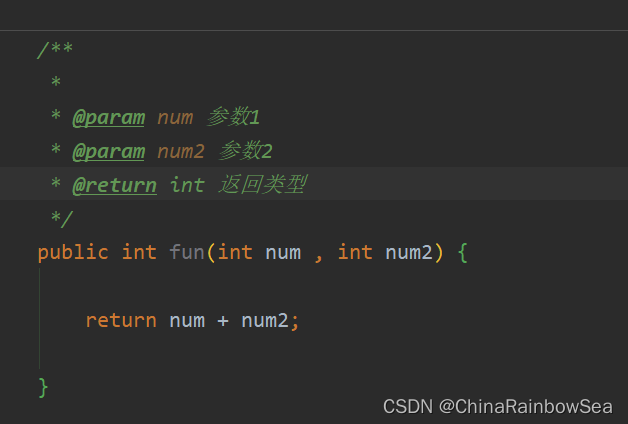
- @author 标明开发该类模块的作者,多个作者之间使用,分割。
- @version 标明该类的模块的版本。
- @see 参考转向,也就是相关类的主题。
- @since 从哪个版本开始增加的。
- @param 对方法中某参数的说明,如果没有参数就不能写。
- @return 对方法返回值的说明,如果方法的返回值类型是 void 就不能写
- @exception 对方法可能抛出的异常进行说明,如果方法没有用 throws 显抛出的异常就不能写 其中:
- @param @ return 和 @ exeption 这三个标记都是只用于方法的。
- @param 的格式要求:@param 形参名 形参类型 形参说明
- @return 的格式要求:@return 返回值类型 返回值说明
- @exception 的格式要求:@exception 异常类型 异常说明
- @ param 和 @exception 可以并列多个。
4. 自定义注解
Annotaion注解 其实也是一种引用数据类型,编译之后也是生成 xxx.class 字节码文件的。
-
定义新的 Annotation 注解 类型使用 @interface 关键字
-
自定义注解自动实现了
java.lang.annotation.Annotation接口

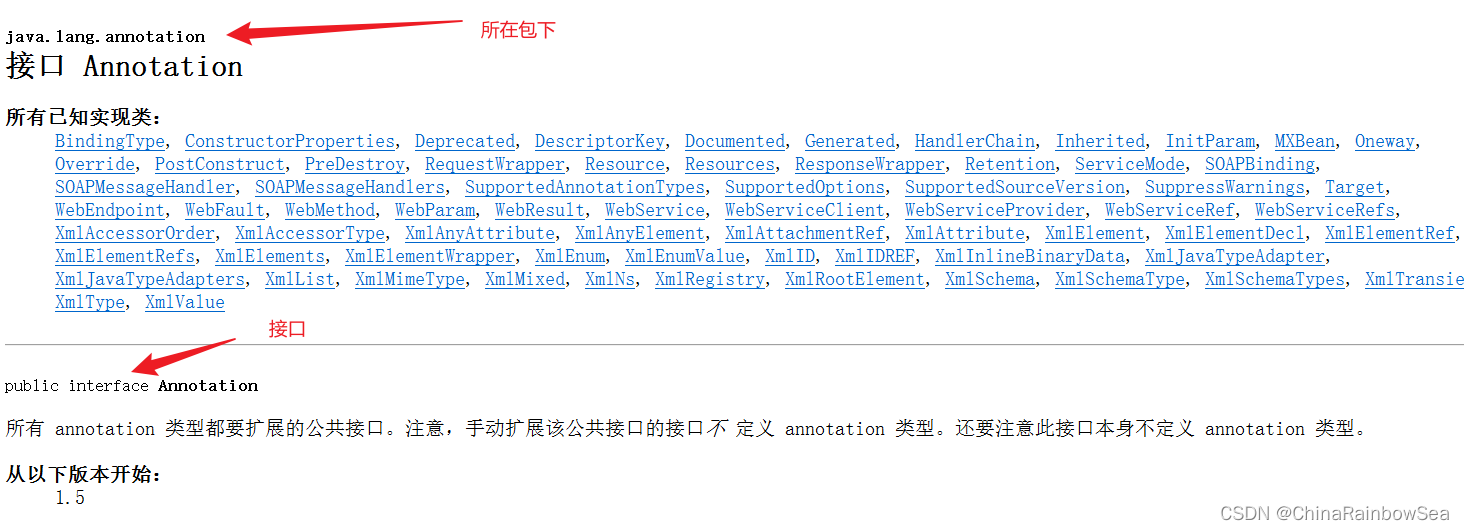
自定义注解的格式如下:
public @interface MyAnnotation {
}
//
[修饰列表] @interface 注解名/(注解类名) {
}
使用 IDEA 创建一个 注解类型: 鼠标右键 ——> new 一个选择 :
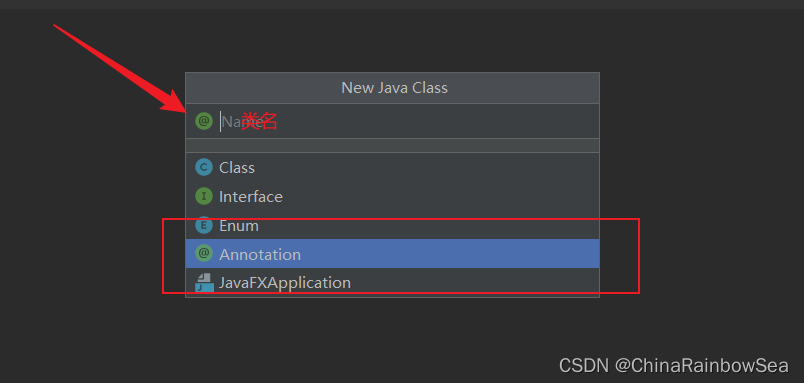
如下查看该 我们该自定义的注解 MyAnnotation 的 UML 图:可以清楚的看到该 注解类型是自动继承了该 java.lang.annotation.Annotation 接口的
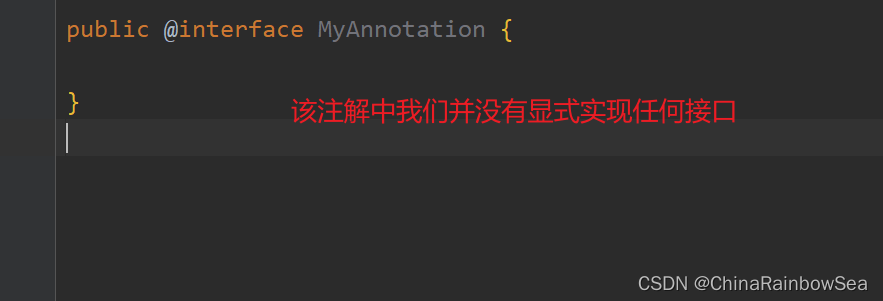
但是事实上却是自动实现了 java.lang.annotation.Annotation 接口。
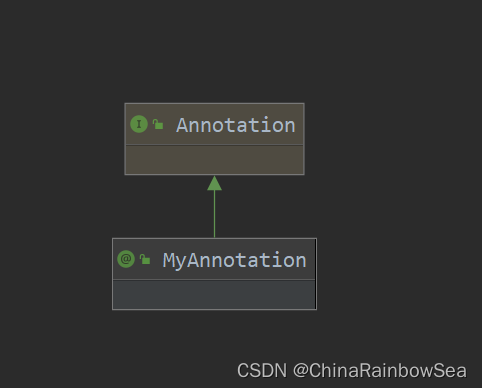
在Java 8之前,注解只能是在声明的地方所使用,Java8 开始,注解可以应用 在任何地方 。这里的任何地方包括:包,类,构造器,方法,成员变量,参数,局部变量的声明 。这些信息被保存在 注解 Annotaion 的“ name = value” 键值对中。
举例如下: 并没有出现任何的报错的情况。
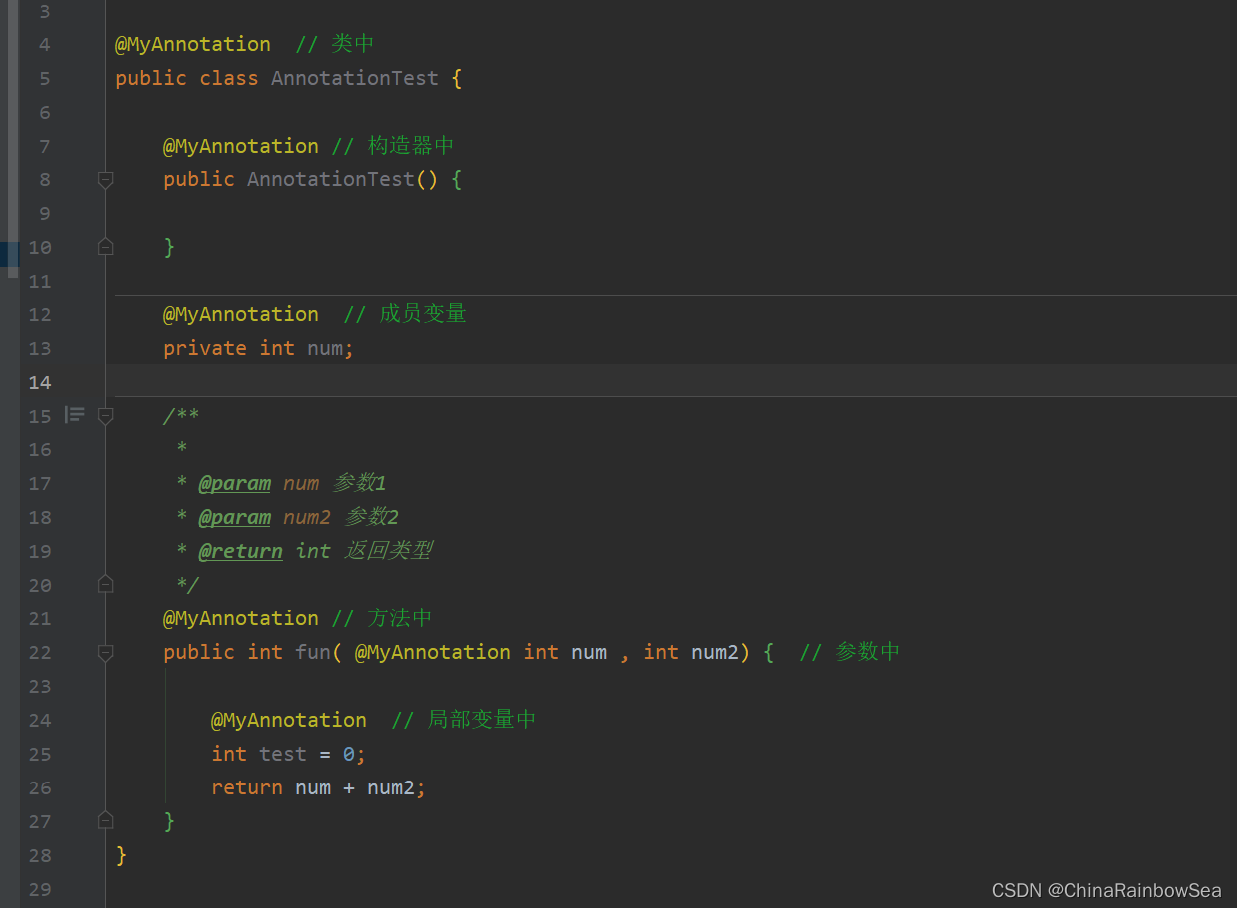
4.1 注解中的属性
在注解中可以定义属性。
Java中的注解中的属性:看着像方法,但实际在注解当中是属性 name
格式如下:
String value();
// 数据类型 属性名(); // 看似是方法,其实在注解中是属性
注解中的属性可以是任何类型:byte, short, int, long, float, double, boolean, char, String, long, Class, 枚举类型。再或者是自定义类型。
举例:
public @interface MyAnnotation {
String value();
}
注意: 如果该注解中定义了属性,则声明使用该注解时 必须 为其注解中的属性值赋上值,不然,是会报错的。
如下,我们为该 @MyAnnotation 注解定义了属性,使用时却没有赋值,报如下编译错误。

为注解中的属性赋值的格式如下:
@MyAnnotaion(value="Tom") // 注意:在该注解中定义的是什么类型的值,就赋值对应的值,不然会报错的
// @注解名(注解中的属性名=对应赋值的属性值)
举例:
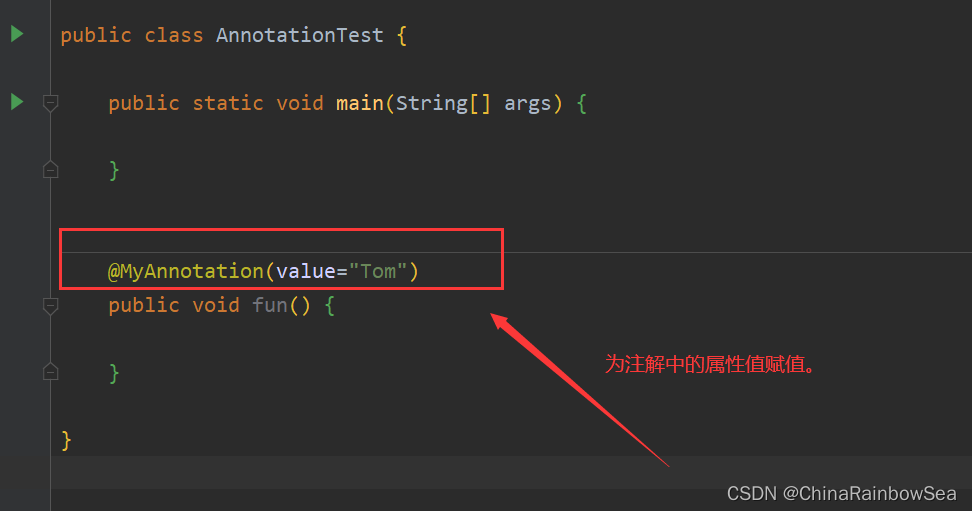
如果该注解中只有一个属性值,并且该注解的属性名为 value ,则在赋值时,可以省略其 为value的属性名,直接写值 。
注意一定要满足两个条件:1. 该注解中只有一个属性值,2.该属性名为 value
举例:
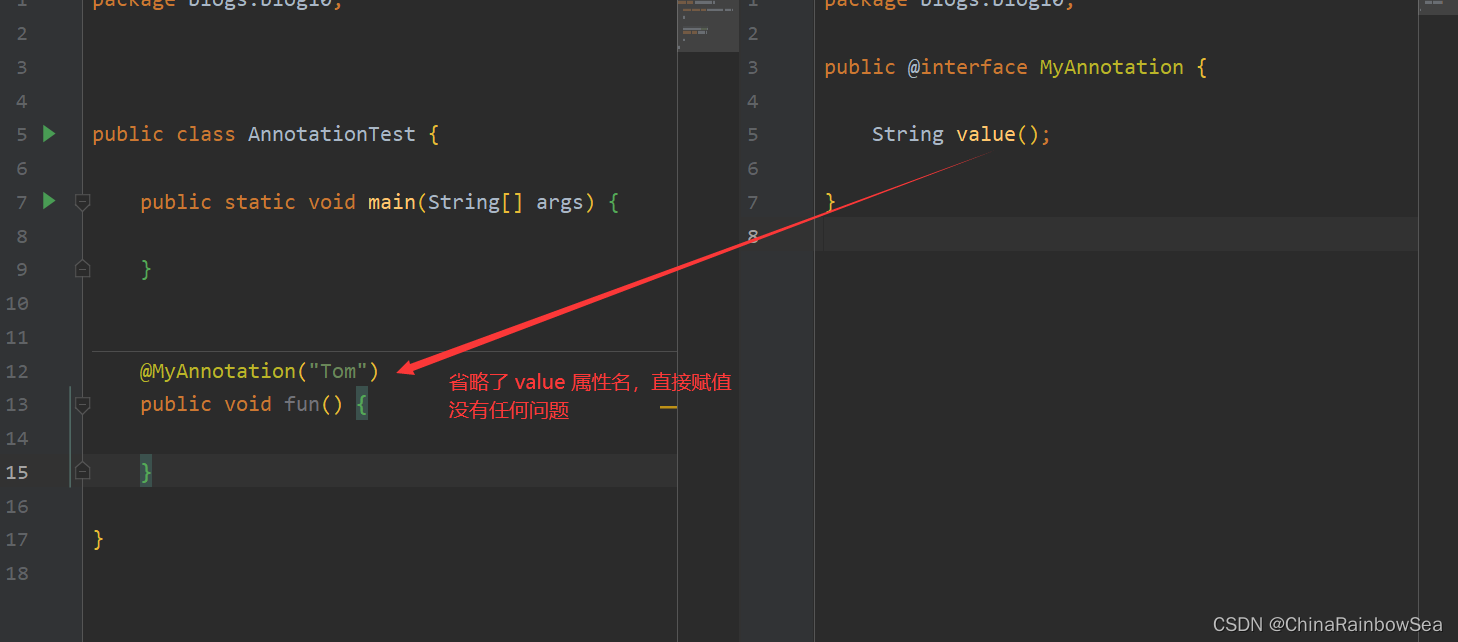
为注解中的多个属性赋值格式如下: 多个属性值,使用逗号分隔开来,就可以了。
@MyAnnotation(value = "Tom",value2 = "123")
// @注解名(注解中的属性名=值,注解中的属性名=值) :多个属性值使用逗号分隔开。
注意: 当注解中存在多个属性值时,其中所有该注解中的属性值都必须赋值,不然编译报错,如下:
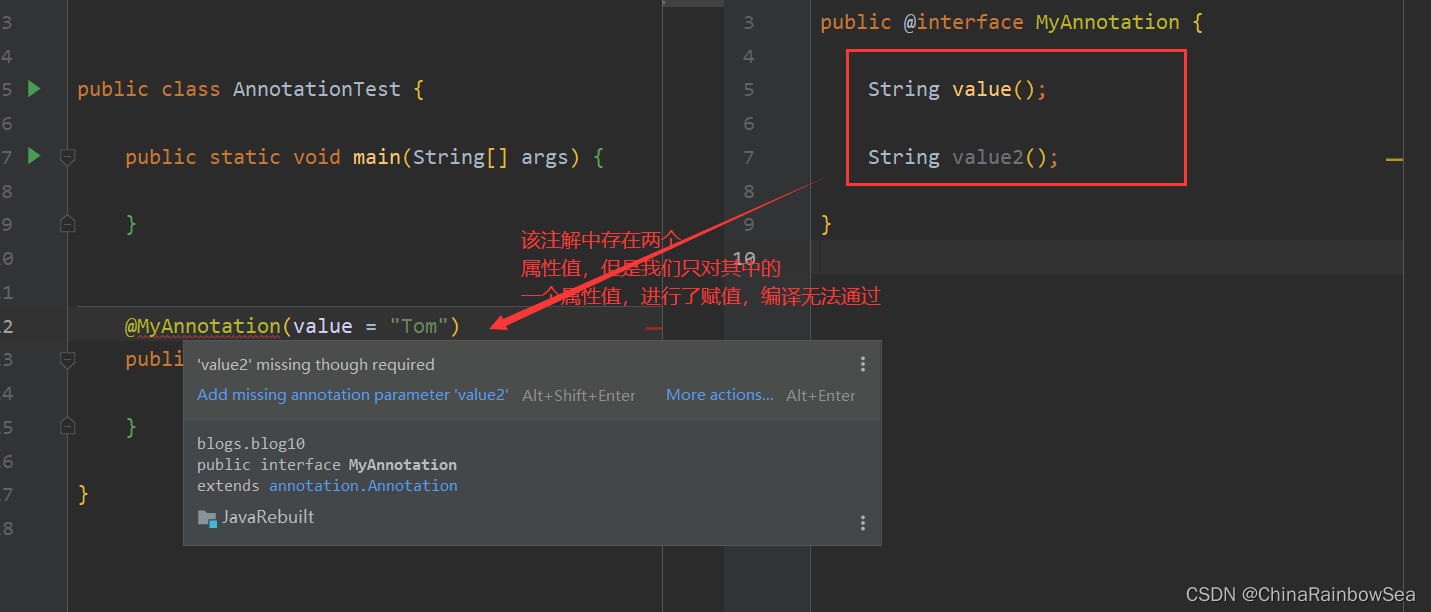
必须将注解中的所有属性值都赋值上值才行:如下:如果注解中存在两个或两个以上的属性,就算其中存在一个属性名为 value ,其赋值时,该value 属性名是不可以省略的。必须写明所有的属性名的进行赋值。[外链图片转存失败,源站可能有防盗链机制,建议将图片保存下来直接上传
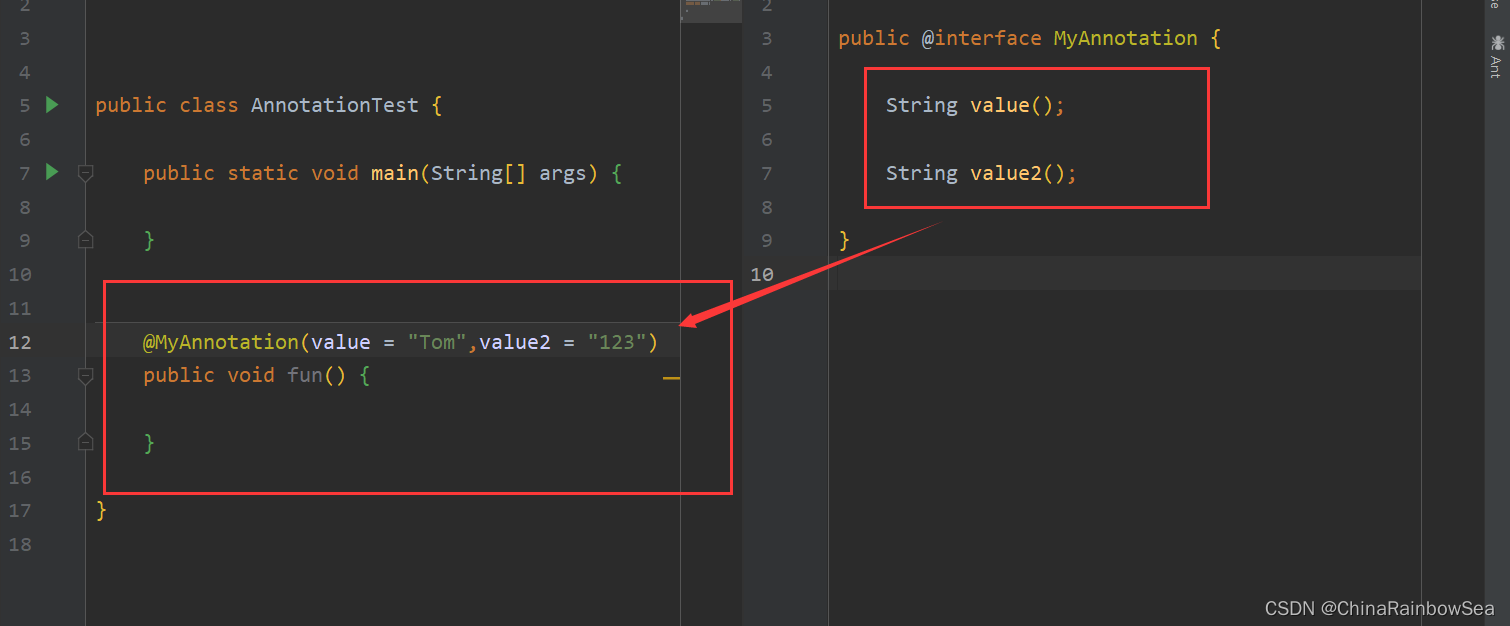
注解中的属性可以设置默认值,使用关键字``格式如下:
String value() default "Tom";
// 数据类型 属性名() default 默认值; 注意需要和定义的类型保证一致。
举例:
public @interface MyAnnotation {
String value() default "Tom";
}
注解中属性设置了,默认值的是可以选择不进行赋值操作,使用定义的默认值。
举例如下:
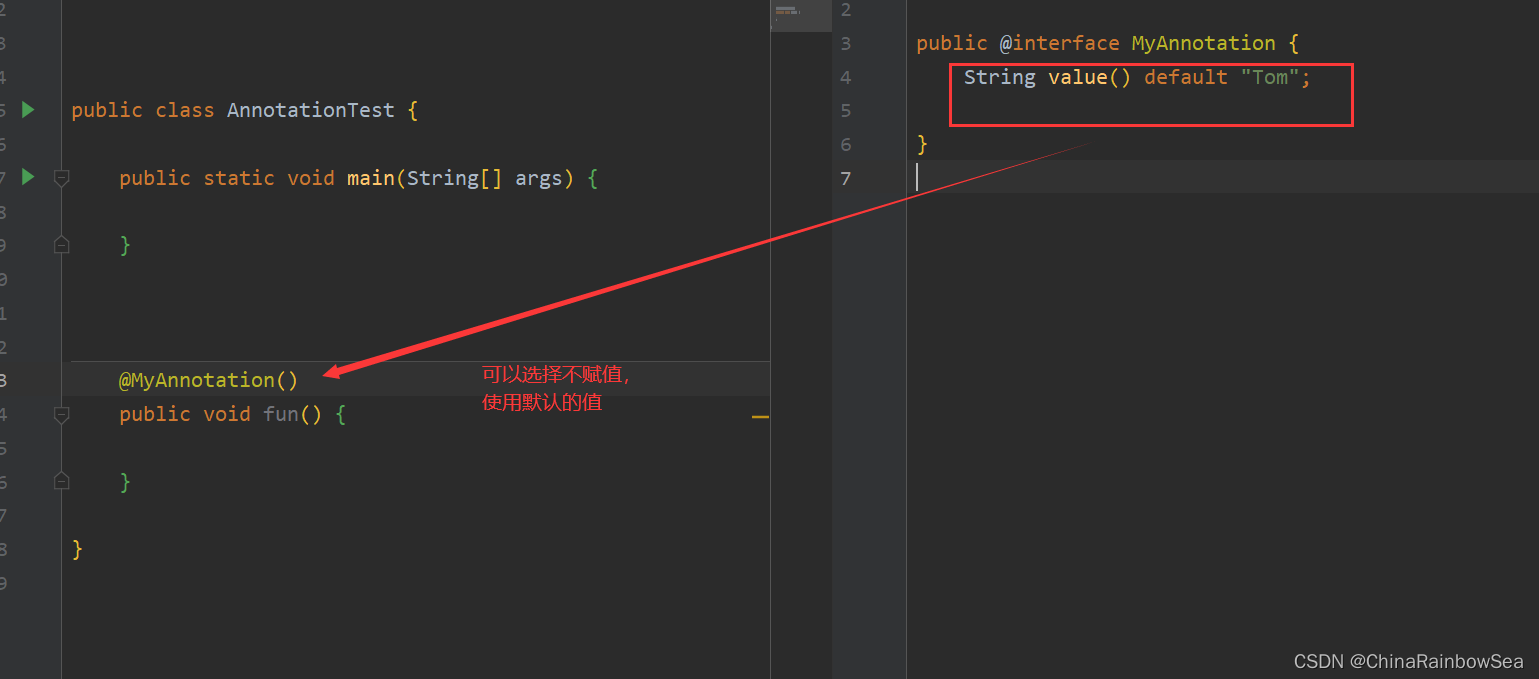
4.2 注解中属性为:数组的赋值
注解中的属性值是可以定义为数组属性的格式如下:
String[] arr(); // 定义数组为属性值
数据类型[] 属性名();
举例:
public @interface MyAnnotation {
String value();
String[] arr();
}
注解中以数组为属性的赋值格式如下:
@MyAnnotation(value = "Tom",arr = {"hello","world"})
@注解名(属性名=值,属性名={值,值})
举例:
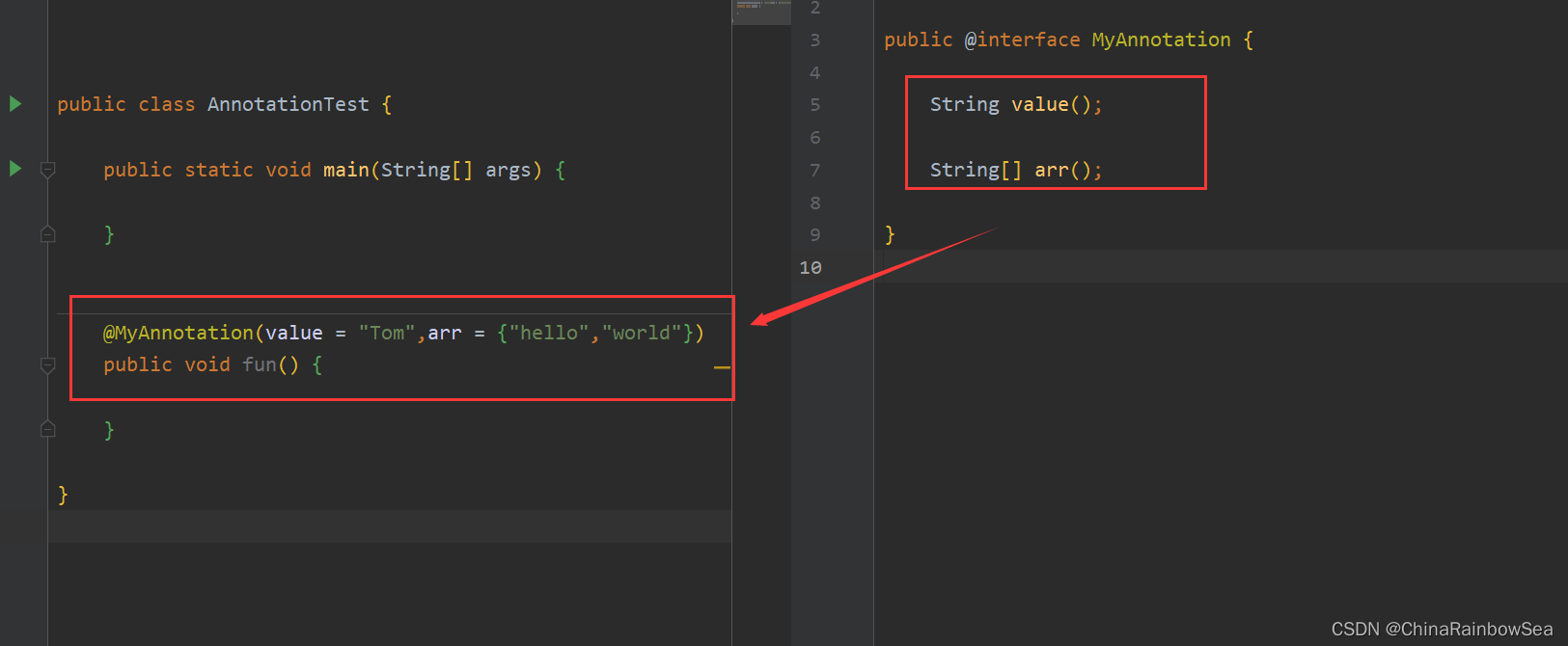
当数组属性所赋值的参数只有一个时,可以省略{} 花括号。如下
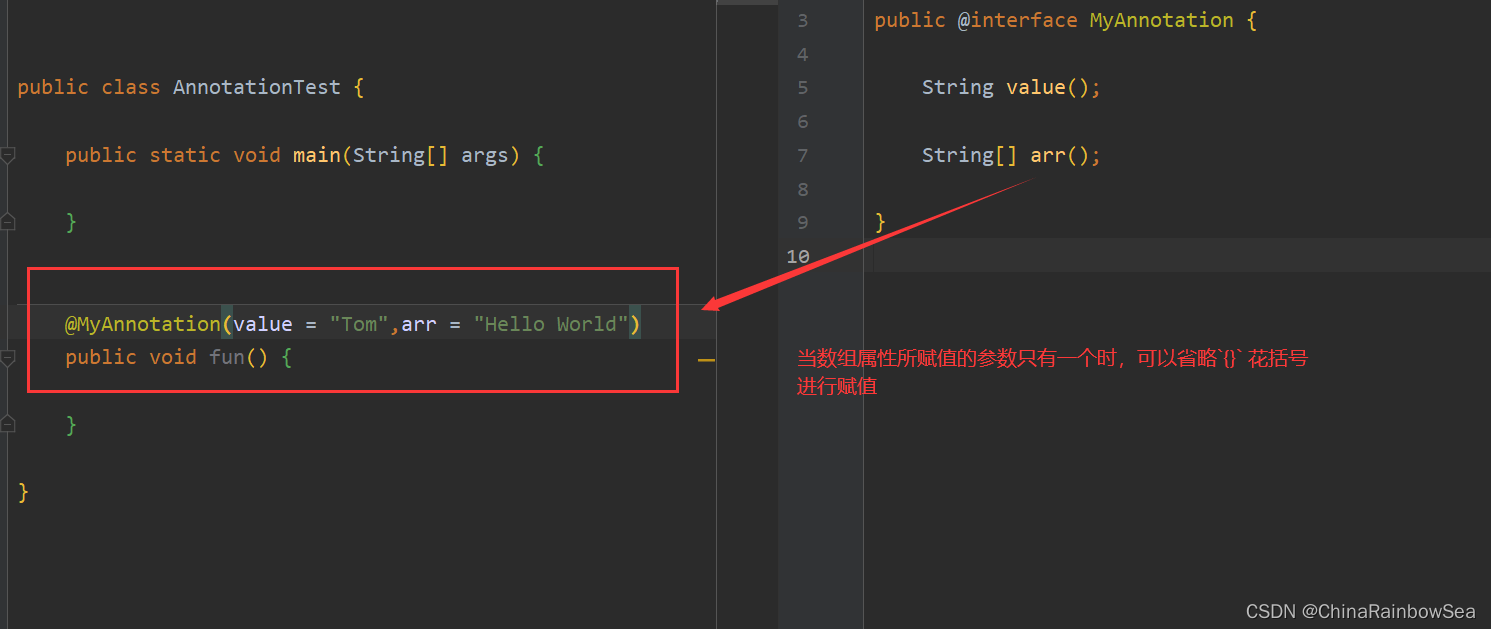
5. JDK 内置的三个基本注解
下面我们来认识一下,JDK 中三个常见的基本注解。
5.1 @Override: 限定重写父类方法, 该注解只能用于方法

@Override : 的作用就是在编译期间:让编译器检查该方法是否正确的实现了 重写 操作。其中的重写的方法名是否存在错误,方法的返回值类型是否是父类中/接口中的一致。不一致编译报错,提示我们改正。
@OVerride 注解的源码,可以看到该注解是没有定义属性的。
package java.lang;
import java.lang.annotation.*;
/**
* Indicates that a method declaration is intended to override a
* method declaration in a supertype. If a method is annotated with
* this annotation type compilers are required to generate an error
* message unless at least one of the following conditions hold:
*
* -
* The method does override or implement a method declared in a
* supertype.
*
-
* The method has a signature that is override-equivalent to that of
* any public method declared in {@linkplain Object}.
*
*
* @author Peter von der Ahé
* @author Joshua Bloch
* @jls 9.6.1.4 @Override
* @since 1.5
*/
@Target(ElementType.METHOD)
@Retention(RetentionPolicy.SOURCE)
public @interface Override {
}
注意 : 该注解只能使用在方法上(因为该注解的源码中被@Target(ElementType.METHOD)元注解修饰了),在其他位置上是会编译报错的。如下:
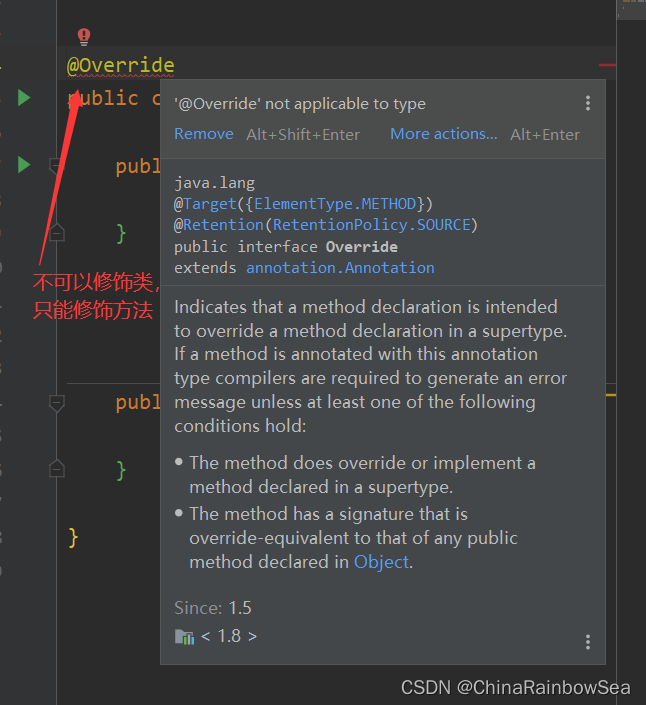
@OVerride 注解的使用: 较少了我们编程程序时,上的简单符号上以及一些基本的语法错误。
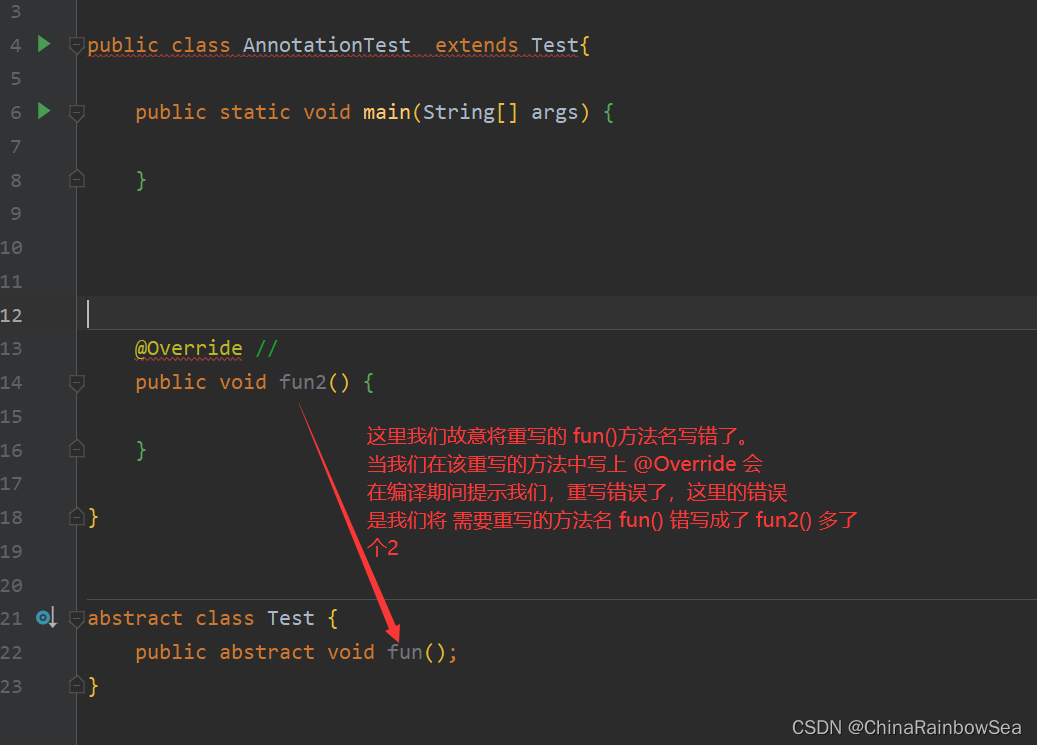
5.2 @Deprecated: 用于表示所修饰的元素(类, 方法等)已过时。

@Deprecated : 该注解表示:表示所修饰的元素(类,方法等)已过时了,不建议使用它了。建议替换成其他的方法。
@Depecated 源码: 可以看到该注解是没有定义属性的。
package java.lang;
import java.lang.annotation.*;
import static java.lang.annotation.ElementType.*;
/**
* A program element annotated @Deprecated is one that programmers
* are discouraged from using, typically because it is dangerous,
* or because a better alternative exists. Compilers warn when a
* deprecated program element is used or overridden in non-deprecated code.
*
* @author Neal Gafter
* @since 1.5
* @jls 9.6.3.6 @Deprecated
*/
@Documented
@Retention(RetentionPolicy.RUNTIME)
@Target(value={CONSTRUCTOR, FIELD, LOCAL_VARIABLE, METHOD, PACKAGE, PARAMETER, TYPE})
public @interface Deprecated {
}
常见的,在我们的 java.util.lang 包下的 Date 中的 Date(String s) 构造器是被 @Deprecated 注解修饰了的。

在IDEA 中 如果我们调用了,被 @Deprecated 修饰的属性,方法,构造器,会给一个直观的将该属性/方法以删除线的方式显示处理并提示你建议使用别的方式替换 。如下

我们也可以自己写一个这样的被@Deprecated 修饰的属性/方法/类/构造器。举例如下:
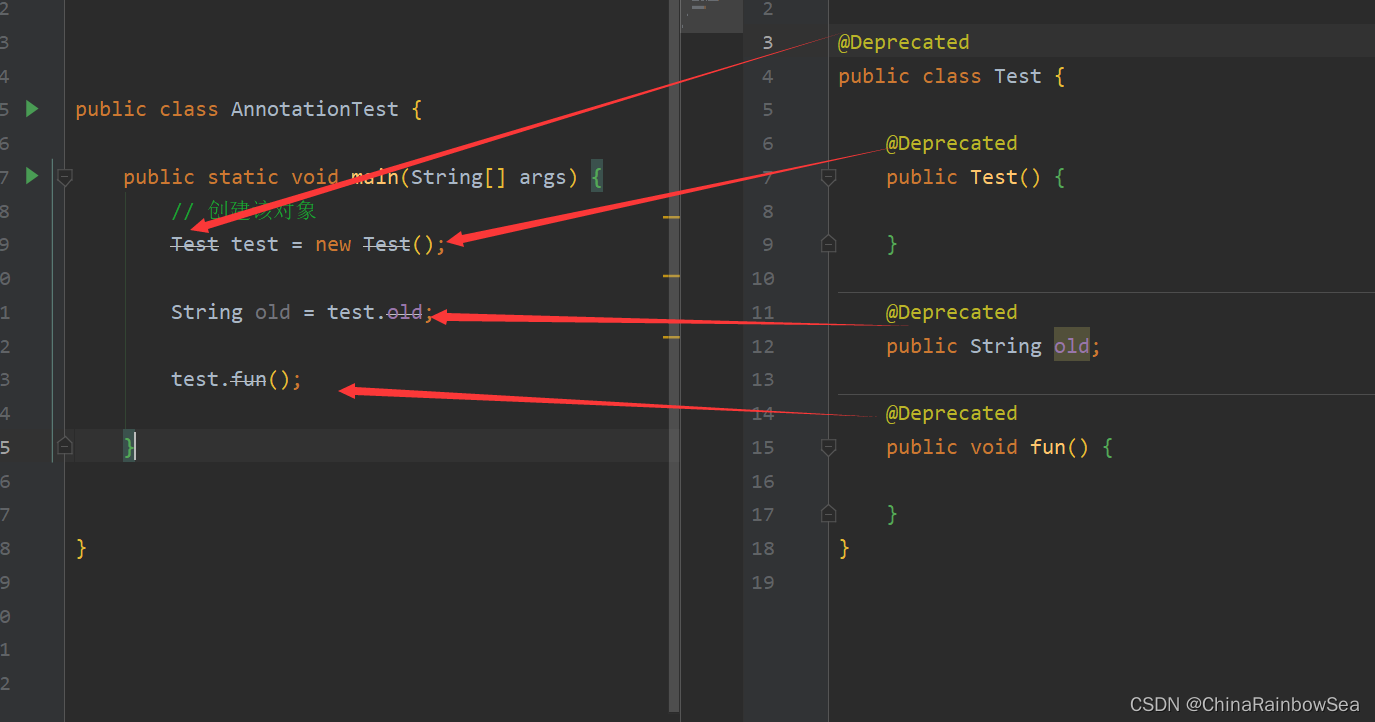
5.3 @SuppressWarnings: 抑制编译器警告

@SuppressWarnings ** :指示应该在注解元素(以及包含在该注解元素中所有程序元素中的所有程序元素)中取消显示指定的编译器警告。换句话说:就是告诉编译器忽略此处代码产生的警告**。 注意是警告不是异常。
@SuppressWarnings的源码 ,可以看到该注解定义了一个名为 value 的属性。
package java.lang;
import java.lang.annotation.*;
import static java.lang.annotation.ElementType.*;
/**
* Indicates that the named compiler warnings should be suppressed in the
* annotated element (and in all program elements contained in the annotated
* element). Note that the set of warnings suppressed in a given element is
* a superset of the warnings suppressed in all containing elements. For
* example, if you annotate a class to suppress one warning and annotate a
* method to suppress another, both warnings will be suppressed in the method.
*
* As a matter of style, programmers should always use this annotation
* on the most deeply nested element where it is effective. If you want to
* suppress a warning in a particular method, you should annotate that
* method rather than its class.
*
* @author Josh Bloch
* @since 1.5
* @jls 4.8 Raw Types
* @jls 4.12.2 Variables of Reference Type
* @jls 5.1.9 Unchecked Conversion
* @jls 5.5.2 Checked Casts and Unchecked Casts
* @jls 9.6.3.5 @SuppressWarnings
*/
@Target({TYPE, FIELD, METHOD, PARAMETER, CONSTRUCTOR, LOCAL_VARIABLE})
@Retention(RetentionPolicy.SOURCE)
public @interface SuppressWarnings {
/**
* The set of warnings that are to be suppressed by the compiler in the
* annotated element. Duplicate names are permitted. The second and
* successive occurrences of a name are ignored. The presence of
* unrecognized warning names is not an error: Compilers must
* ignore any warning names they do not recognize. They are, however,
* free to emit a warning if an annotation contains an unrecognized
* warning name.
*
* The string {@code "unchecked"} is used to suppress
* unchecked warnings. Compiler vendors should document the
* additional warning names they support in conjunction with this
* annotation type. They are encouraged to cooperate to ensure
* that the same names work across multiple compilers.
* @return the set of warnings to be suppressed
*/
String[] value();
}
举例: 这里我们定义一个 int num = 1 / 0 语句,IDEA 该我们提示了警告了。
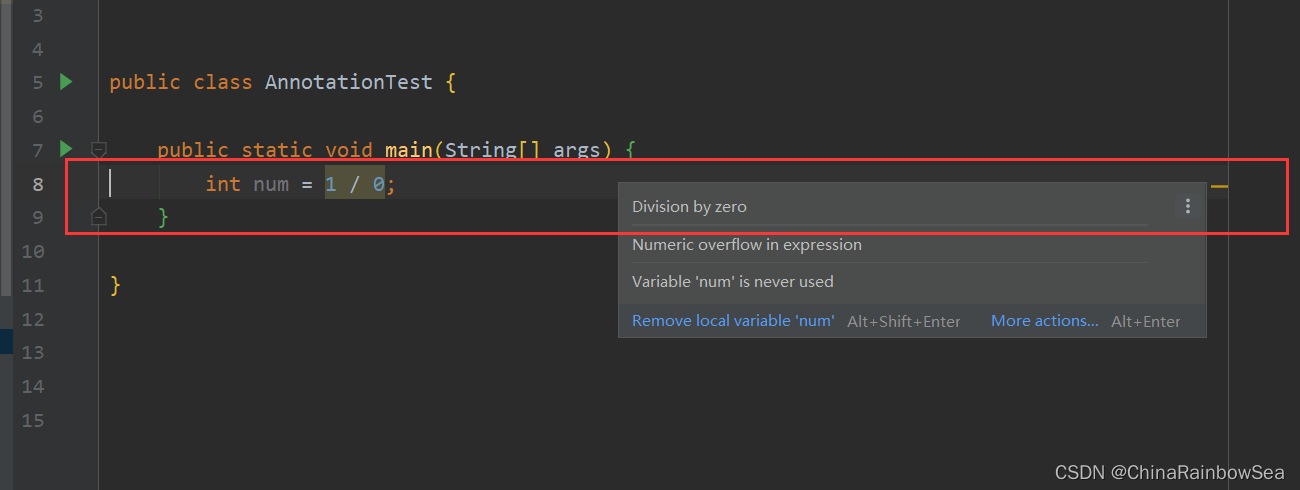
当我们加上了 @SuppressWarnings IDEA 就没有这个警告了。如下:
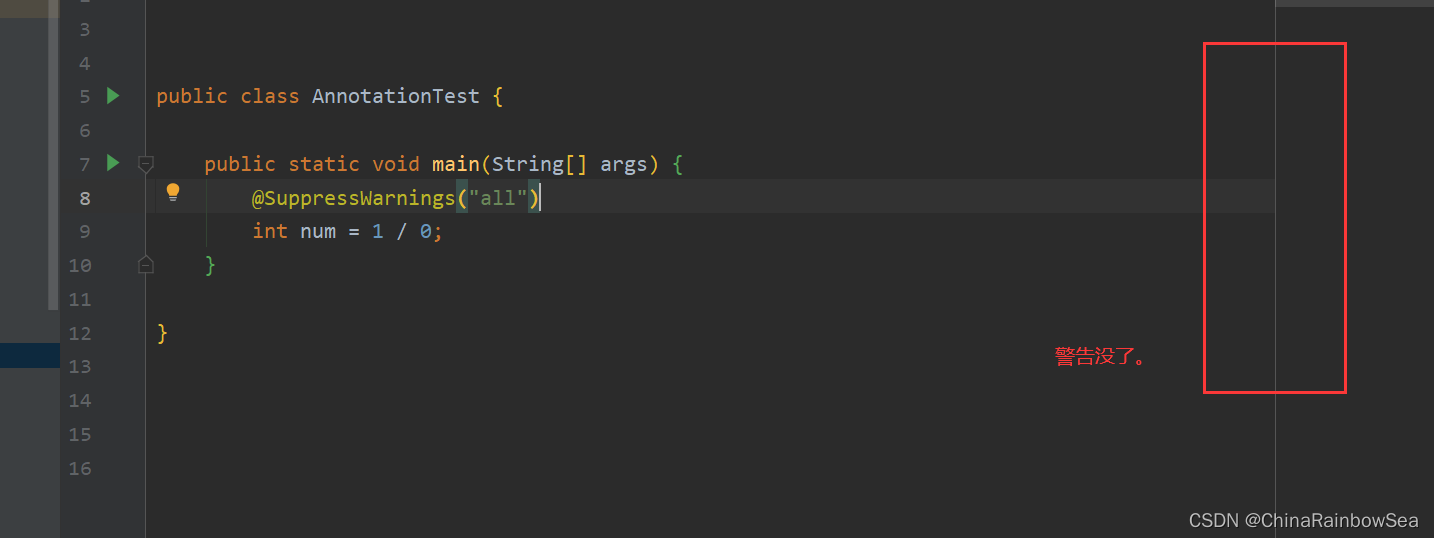
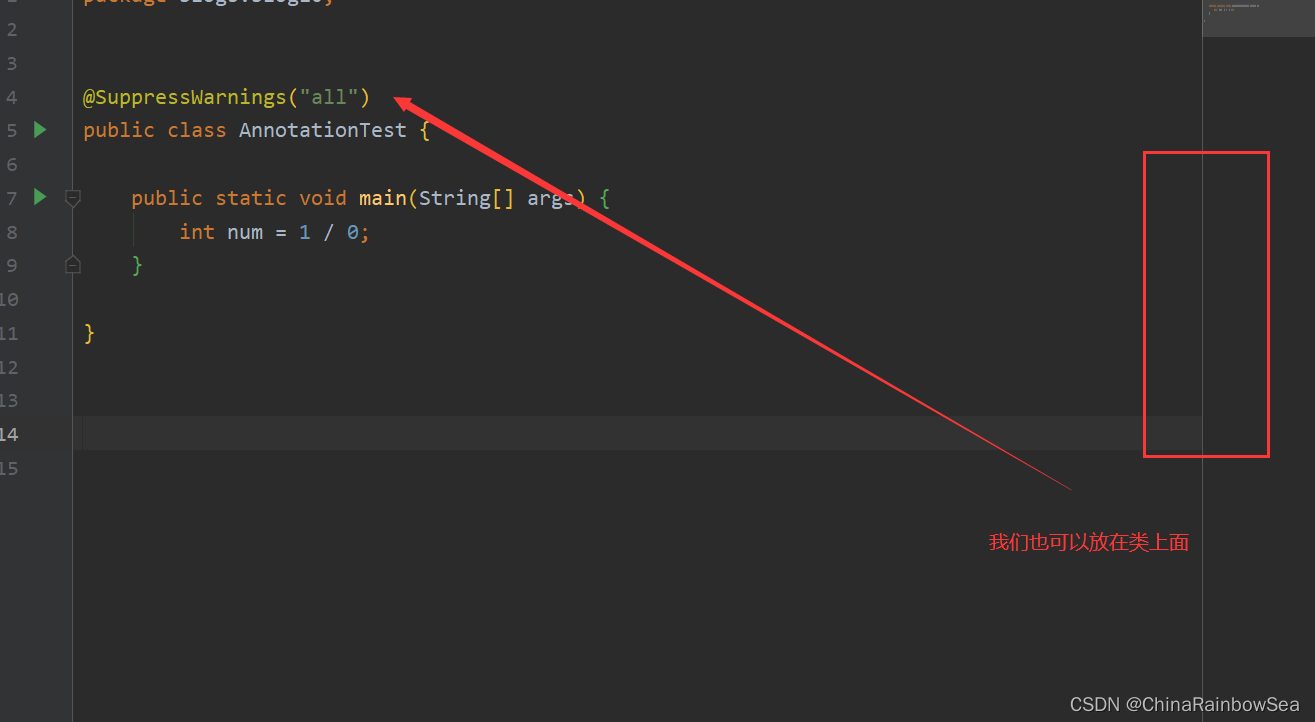
具体的其他应用大家可以移步至:🔜🔜🔜
https://blog.csdn.net/qq_43842093/article/details/122386115?ops_request_misc=&request_id=&biz_id=102&utm_term=%20@SuppressWarnings%E7%9A%84%E4%BD%BF%E7%94%A8&utm_medium=distribute.pc_search_result.none-task-blog-2allsobaiduweb~default-3-122386115.142
Eclipse Galileo版本支持的抑制警告的名称:
| 关键字 | 用途 |
|---|---|
| all | to suppress all warnings (抑制所有警告) |
| boxing | to suppress warnings relative to boxing/unboxing operations (抑制装箱、拆箱操作时候的警告) |
| cast | to suppress warnings relative to cast operations (抑制映射相关的警告) |
| dep-ann | to suppress warnings relative to deprecated annotation (抑制启用注释的警告) |
| deprecation | to suppress warnings relative to deprecation (抑制过期方法警告) |
| fallthrough | to suppress warnings relative to missing breaks in switch statements (抑制确在switch中缺失breaks的警告) |
| finally | to suppress warnings relative to finally block that don’t return (抑制finally模块没有返回的警告) |
| hiding | to suppress warnings relative to locals that hide variable(抑制相对于隐藏变量的局部变量的警告) |
| incomplete-switch | to suppress warnings relative to missing entries in a switch statement (enum case)(忽略没有完整的switch语句) |
| nls | to suppress warnings relative to non-nls string literals( 忽略非nls格式的字符) |
| null | to suppress warnings relative to null analysis( 忽略对null的操作) |
| rawtypes | to suppress warnings relative to un-specific types when using generics on class params( 使用generics时忽略没有指定相应的类型) |
| restriction | to suppress warnings relative to usage of discouraged or forbidden references( 抑制禁止使用劝阻或禁止引用的警告) |
| serial | to suppress warnings relative to missing serialVersionUID field for a serializable class( 忽略在serializable类中没有声明serialVersionUID变量) |
| static-access | to suppress warnings relative to incorrect static access( 抑制不正确的静态访问方式警告) |
| synthetic-access | to suppress warnings relative to unoptimized access from inner classes( 抑制子类没有按最优方法访问内部类的警告) |
| unchecked | to suppress warnings relative to unchecked operations( 抑制没有进行类型检查操作的警告) |
| unqualified-field-access | to suppress warnings relative to field access unqualified( 抑制没有权限访问的域的警告) |
| unused | to suppress warnings relative to unused code( 抑制没被使用过的代码的警告) |
6. 元注解
有一些注解可以修饰其他注解,这些注解就称为元注解(meta annotation)。Java标准库已经定义了一些元注解,我们只需要使用元注解,通常不需要自己去编写元注解。
6.1 @Target

@Target 源码:其中存在一个类型为 ElementType[] 枚举类型数组属性名为 value 的属性。
package java.lang.annotation;
@Documented
@Retention(RetentionPolicy.RUNTIME)
@Target(ElementType.ANNOTATION_TYPE)
public @interface Target {
/**
* Returns an array of the kinds of elements an annotation type
* can be applied to.
* @return an array of the kinds of elements an annotation type
* can be applied to
*/
ElementType[] value();
}
ElementType的枚举源码 :
/package java.lang.annotation;
public enum ElementType {
/** Class, interface (including annotation type), or enum declaration */
TYPE,
/** Field declaration (includes enum constants) */
FIELD,
/** Method declaration */
METHOD,
/** Formal parameter declaration */
PARAMETER,
/** Constructor declaration */
CONSTRUCTOR,
/** Local variable declaration */
LOCAL_VARIABLE,
/** Annotation type declaration */
ANNOTATION_TYPE,
/** Package declaration */
PACKAGE,
/**
* Type parameter declaration
*
* @since 1.8
*/
TYPE_PARAMETER,
/**
* Use of a type
*
* @since 1.8
*/
TYPE_USE
}
@Target : 最常用的元注解是@Target。使用@Target可以定义Annotation能够被应用于源码的哪些位置:
- 类或接口:
ElementType.TYPE; - 字段:
ElementType.FIELD; - 方法:
ElementType.METHOD; - 构造方法:
ElementType.CONSTRUCTOR; - 方法参数:
ElementType.PARAMETER。
举例:

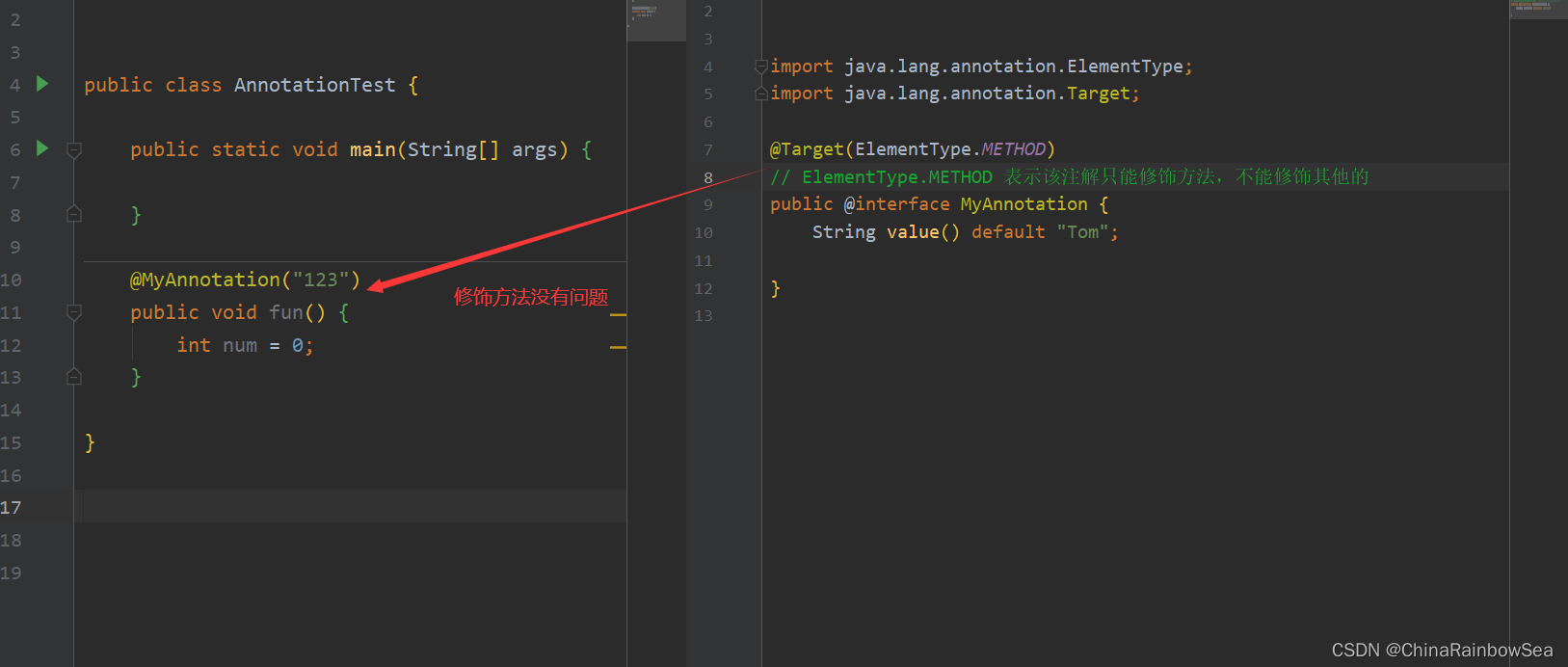
@Target元注解中的 value 属性是枚举数组类型的,可以赋值多个值:比如表示该注解可以声明在方法,变量,类中 ,举例:
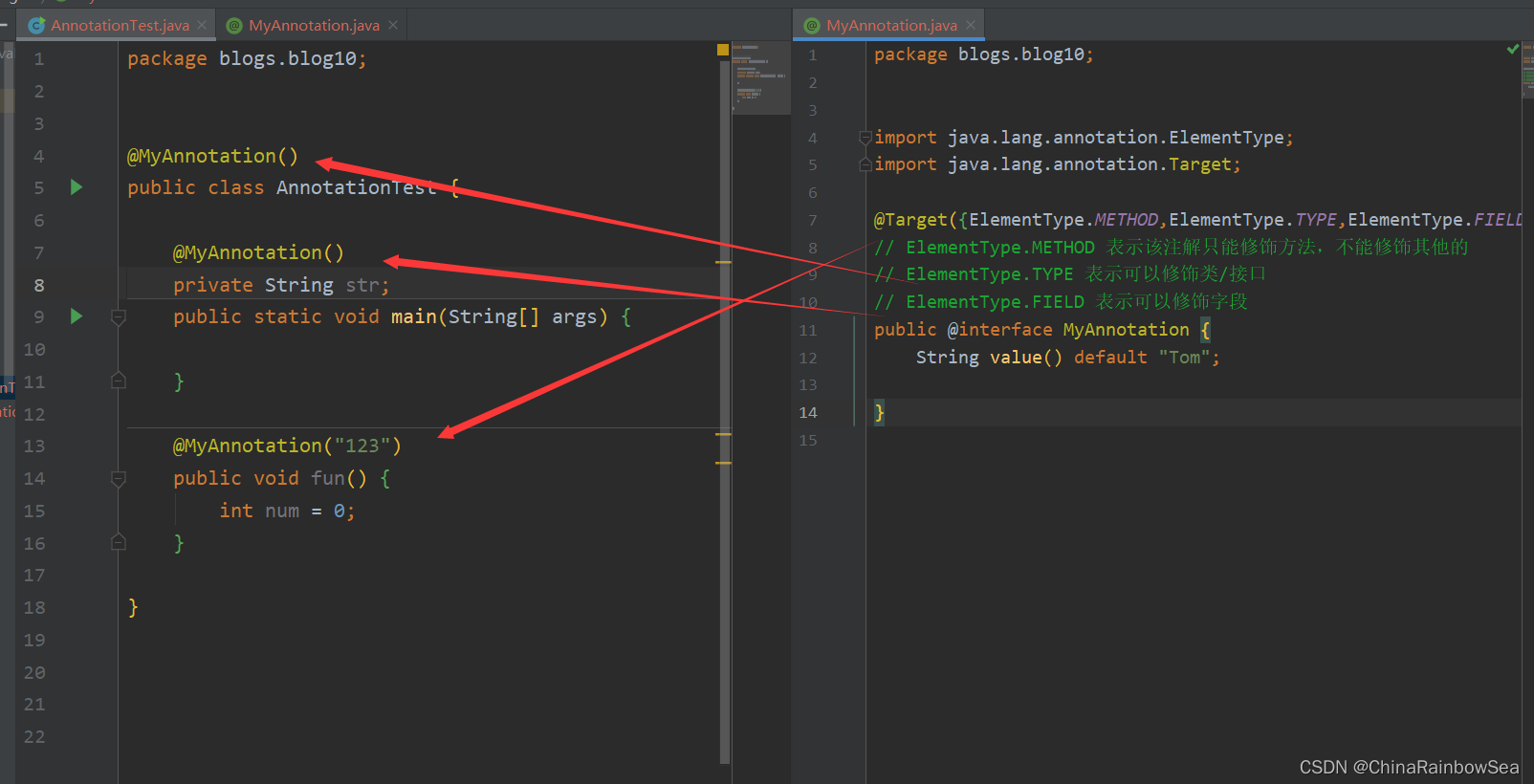
6.2 @Retention
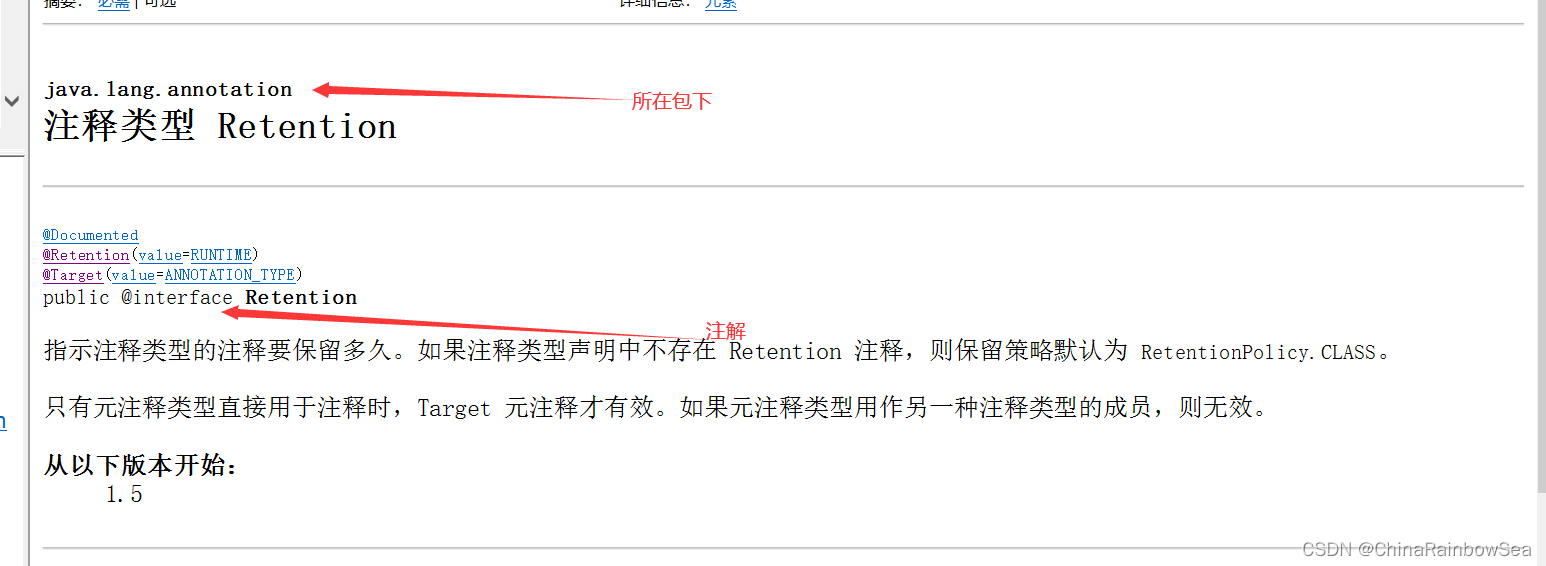
@Retention 源码 : 我们可以看到如下注解中只定义了一个RetentionPolicy 的枚举类型名为 value 的属性名的属性
package java.lang.annotation;
@Documented
@Retention(RetentionPolicy.RUNTIME)
@Target(ElementType.ANNOTATION_TYPE)
public @interface Retention {
/**
* Returns the retention policy.
* @return the retention policy
*/
RetentionPolicy value();
}
RetentionPolicy 枚举类型的源码
package java.lang.annotation;
public enum RetentionPolicy {
/**
* Annotations are to be discarded by the compiler.
*/
SOURCE,
/**
* Annotations are to be recorded in the class file by the compiler
* but need not be retained by the VM at run time. This is the default
* behavior.
*/
CLASS,
/**
* Annotations are to be recorded in the class file by the compiler and
* retained by the VM at run time, so they may be read reflectively.
*
* @see java.lang.reflect.AnnotatedElement
*/
RUNTIME
}
@Retention : 另一个重要的元注解@Retention定义了Annotation的生命周期:
@Rentention 时必须为该 value 成员变量指定值
- 仅编译期:
RetentionPolicy.SOURCE表示该注解的生命周期只在编译期间有效,在源文件中有效(即源文件保留),编译器直接丢弃这种策略的注释。 - 仅class文件:
RetentionPolicy.CLASS: 在class文件中有效(即class保留) , 当运行 Java 程序时, JVM 不会保留注解。 这是默认值 - 运行期:
RetentionPolicy.RUNTIME,注意:只有定义该属性的注解,才能被反射读取到。上面两种方式都无法被反射读取到的。
如果@Retention不存在,则该Annotation默认为CLASS。因为通常我们自定义的Annotation都是RUNTIME,所以,务必要加上@Retention(RetentionPolicy.RUNTIME)这个元注解:
举例:
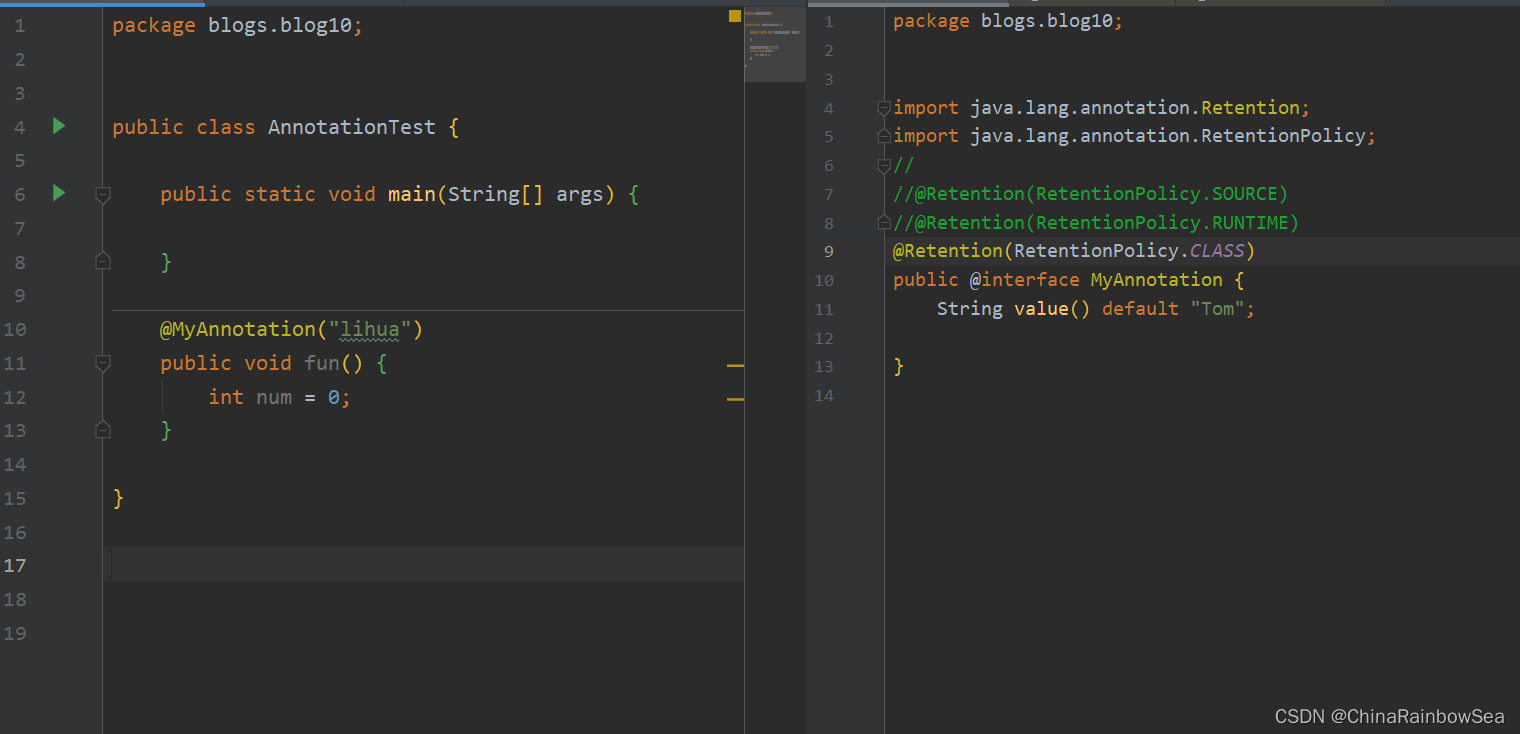
6.3 @Documented

@Documented: 用于指定被该元 Annotation 修饰的 Annotation 类将被 javadoc 工具提取成文档。默认情况下,javadoc是不包括注解的。
- 定义为Documented的注解必须设置Retention值为RUNTIME
@Documented 的源码 从源码看,该注解没有任何属性。
package java.lang.annotation;
@Documented
@Retention(RetentionPolicy.RUNTIME)
@Target(ElementType.ANNOTATION_TYPE)
public @interface Documented {
}
6.4 @Inherited
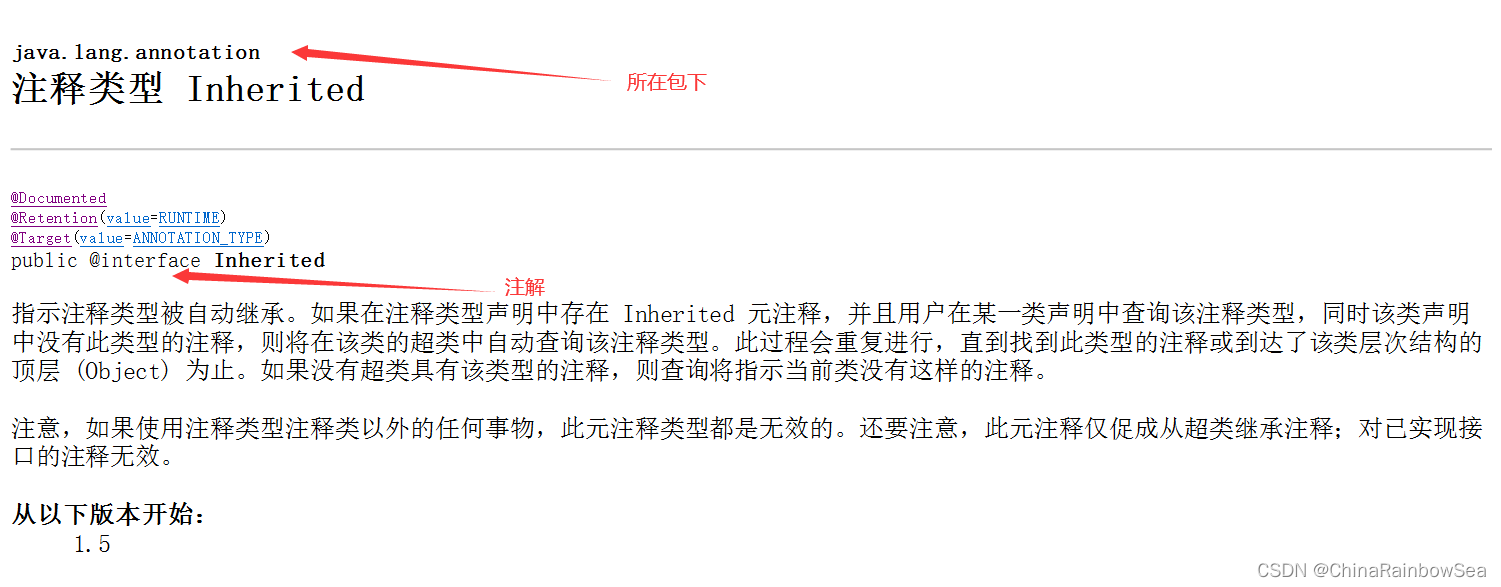
@Inherited: 被它修饰的 Annotation 将具有继承性。如果某个类使用了被
@Inherited : 修饰的 Annotation, 则其子类将自动具有该注解。
-
比如:如果把标有@Inherited注解的自定义的注解标注在类级别上,子类则可以继承父类类级别的注解
-
实际应用中,使用较少
@Inherited 源码 从源码看,该注解没有任何属性。
package java.lang.annotation;
@Documented
@Retention(RetentionPolicy.RUNTIME)
@Target(ElementType.ANNOTATION_TYPE)
public @interface Inherited {
}
7. 通过反射获取到注解信息
想要让反射可以读取到注解中的信息,则该反射中的元注解必须是: @Retention(RetentionPolicy.RUNTIME) 才行。
举例: 这里我们使用反射读取到 fun() 方法中的 注解中的 value 属性值:
注解
package blogs.blog10;
import java.lang.annotation.Retention;
import java.lang.annotation.RetentionPolicy;
@Retention(RetentionPolicy.RUNTIME) // 生命周期在:运行期,才可以被反射读取到
public @interface MyAnnotation {
String value() default "Tom";
}
package blogs.blog10;
import java.lang.reflect.Method;
public class AnnotationTest {
public static void main(String[] args) {
Method method = null;
try {
// 获取类加载器,类对象
Class clazz = Class.forName("blogs.blog10.AnnotationTest"); // 全类路径名
// 获取 fun()方法
method = clazz.getDeclaredMethod("fun");
} catch (ClassNotFoundException e) {
e.printStackTrace();
} catch (NoSuchMethodException e) {
e.printStackTrace();
}
// 判断该方法是否存在该注解,存在才读取该注解上的属性值
if(method.isAnnotationPresent(MyAnnotation.class)) {
// 获取该注解对象
MyAnnotation annotation = method.getAnnotation(MyAnnotation.class);
// // 获取该注解的属性值,就像对象.属性一样
String value = annotation.value();
System.out.println(value);
}
}
@MyAnnotation("lihua")
public void fun() {
int num = 0;
}
}

8. 总结:
- 设计注解类型时,必须考虑该类型注解的基数。现在可以使用注解零次,一次,或者如果注解的类型被标记为
@Repeatable多次。也可以通过使用@Target元注解来限制注解类型的使用位置。例如,您可以创建只能在方法和字段上使用的可重复注解类型。重要的是仔细设计注解类型,以确保使用注解的程序员发现它尽可能灵活和强大。 - 注解的作用:减少程序中的错误,提高程序员的开发效率。以及框架上的运用。
- 注意:注解中的属性必须赋值,不然编译无法通过,除非该属性设置了默认值信息,建议注解中的属性设置上默认值。
- 当注解中只有一个属性,并且该属性名为
value,则在赋值上可以省略属性名。 - 注解多个值上的赋值,以及数组类型的属性值的赋值。
- 元注解:修饰注解上的注解,特别掌握:@Target,@Retention 这两个元注解,其中的属性值上的赋值的意义。
9. 最后:
限于自身水平,其中存在的错误,希望大家给予指教,韩信点兵——多多益善 。谢谢大家,江湖再见,后会有期 !!!
